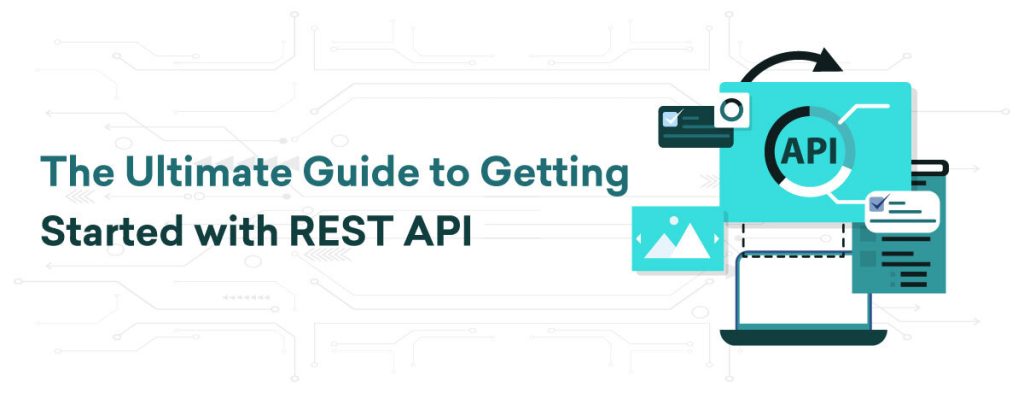A REST API, Representational State Transfer, plays a crucial role in modern software development by enabling smooth interaction between distributed systems. These interfaces allow data and functionality exchange through stateless operations, making them indispensable for developers and Linux system administrators working on scalable, efficient web services.
This guide covers the fundamentals of REST APIs, from their core principles to practical implementations. By illustrating how these APIs can improve server-client communication, our goal is to empower you with the knowledge needed to implement REST principles in your projects effectively. This will boost interoperability and performance in various IT environments. By the end of this section, you will have a solid understanding of why REST APIs are preferred in application development and how they can be utilized efficiently.
What is REST API
REST API is short for Representational State Transfer, and it is a key architectural style used in web services and APIs. RESTful services make use of web protocols like HTTP for client-server interactions. REST is favoured for its simplicity, promoting scalability, performance, and easy integration.
Principles of RESTful Architecture
REST is based on six core principles that shape its architecture and functioning:
1. Client-Server Separation: The client and server function independently, enabling separate development, replacement, and scalability without impacting one another. This division streamlines components on both sides, fostering clear interfaces and improved maintainability.
2. Statelessness: Every client request sent to the server must include all the information necessary for the server to comprehend and process the request. The server does not store any state about the client session on the server side, which enhances reliability and scalability.
3. Cacheability: Responses must define themselves as cacheable or non-cacheable. If a response is cacheable, the client cache is given the right to reuse that response data for later, equivalent requests. Caching can reduce client-server interactions, greatly enhancing efficiency and speed.
4. Uniform Interface: REST simplifies the architecture and separates services from clients by mandating a uniform interface that standardizes interactions between servers and clients. This principle encompasses four key constraints:
- Resource-Based: Individual resources are identified in requests by using URIs as resource identifiers.
- Manipulation of Resources Through Representations: Clients interact with resources through their representations, such as JSON or XML, which carry enough information to modify or delete the resource on the server.
- Self-descriptive Messages: Each message contains sufficient information to explain how to interpret it.
- Hypermedia as the Engine of Application State (HATEOAS): Clients dynamically discover available actions and resources via hypermedia provided by the server
5. Layered System: Typically, a client cannot distinguish if it is connected directly to the end server or to an intermediary in between. Intermediate servers play a crucial role in enhancing system scalability through load balancing and utilizing shared caches.
6. Code on Demand (optional): Servers can temporarily extend or customize a client’s functionality by transferring executable code. This is the only optional constraint of REST.
Key Components of a REST API
A REST API consists of various crucial elements that delineate its structure and operation. Grasping these components is vital for developers and administrators engaged in designing, creating, or incorporating APIs within their systems.
Resources
At the heart of every REST API are the resources, which represent any type of object, data, or service that can be accessed by the client. Each resource is uniquely identified by a URI (Uniform Resource Identifier) and is manipulated through representations. For example, in an API for a social media platform, resources could consist of individual user profiles, photos, or comments.
Requests and Responses
Interactions with resources are carried out using standard HTTP methods, which are fundamental operations of REST APIs:
- GET: Retrieves data from the server. Using GET should only fetch data and not alter any state of the application.
- POST: Sends data to the server for creating a new resource. It is utilized when the client submits information to be processed to the server.
- PUT Updates existing resources. If the resource does not exist, it can be optionally created.
- DELETE: Removes resources from the server.
Each of these requests will trigger a response from the server. This response typically contains a status code indicating the success or failure of the request, and, in cases like a GET request, it includes the data of the requested resource.
Methods of REST API
Apart from the basic methods mentioned earlier, REST APIs also offer:
- PATCH: Used to make partial modifications to a resource. This method is beneficial for updates that impact only specific attributes of a resource instead of replacing the entire resource like PUT does.
The decision between PUT and PATCH is crucial: PUT substitutes an entire resource while PATCH alters it, making PATCH more bandwidth-efficient for minor adjustments.
How REST APIs Work
REST APIs function based on a simple yet robust client-server architecture, which is essential for comprehending their operation and popularity in software development. This structure allows REST APIs to support smooth communication between clients and servers while improving performance and scalability through a stateless communication protocol.
REST Client-Server Architecture
In the RESTful model, the client and server are distinct entities that communicate via HTTP requests and responses. The client sends requests to execute different actions (such as fetching, creating, modifying, or deleting data), and the server handles these requests and sends back suitable responses. This division of responsibilities enables increased flexibility and scalability, as the client and server can progress autonomously without relying directly on each other.
Stateless Interaction
One core principle of REST is statelessness. Each client request to a server must include all necessary information for the server to comprehend and handle the request. The server does not retain any session data about the client; rather, each interaction is handled independently. This method streamlines server design and enhances scalability as the server does not have to uphold, control, or share session state.
Resource Representations
When a client sends a request to a server, it is looking to access a resource. In REST APIs, resources are more than just data – they also include representations of that data. For instance, a client may ask for a resource in formats such as JSON, XML, or HTML. The server then provides the resource in the specified format, along with metadata in the HTTP headers to assist the client in handling the response properly. This adaptability allows different kinds of clients (web browsers, mobile apps, and other servers) to engage with the API in a manner that aligns with their requirements.
Implementing REST APIs
To implement a REST API, you need to set up a server capable of handling HTTP requests and providing suitable responses according to the actions requested by clients. This segment will begin by outlining the fundamental steps and then explore the important factors in developing a RESTful server.
Setting Up a Basic REST Server
The initial phase in creating a REST API is configuring a server capable of handling HTTP requests. This typically requires selecting a server-side language and framework that backs REST architecture, like Node.js with Express, Python with Flask, or Java with Spring Boot. Below is a straightforward example using Python and Flask:
from flask import Flask, jsonify, request
app = Flask(__name__)
# A simple in-memory structure to store
data
data = {
'items': [{'id': 1, 'name': 'Item One'}]
}
# Endpoint to retrieve items
@app.route('/items', methods=['GET'])
def get_items():
return jsonify(data)
# Endpoint to add a new item
@app.route('/items', methods=['POST'])
def add_item():
item = {'id': len(data['items']) + 1, 'name':
request.json['name']}
data['items'].append(item)
return jsonify(item), 201
# Endpoint to update an item
@app.route('/items/',
methods=['PUT'])
def update_item(item_id):
item = next((item for item in data['items']
if item['id'] == item_id), None)
if not item:
return jsonify({'message': 'Item not
found'}), 404
item['name'] = request.json['name']
return jsonify(item)
# Endpoint to delete an item
@app.route('/items/',
methods=['DELETE'])
def delete_item(item_id):
item = next((item for item in data['items']
if item['id'] == item_id), None)
if not item:
return jsonify({'message': 'Item not
found'}), 404
data['items'].remove(item)
return jsonify({'message': 'Item deleted'})
if __name__ == '__main__':
app.run(debug=True)
This basic server setup demonstrates how to manage GET, POST, PUT, and DELETE requests, which form the core of RESTful services. It also highlights the stateless aspect of REST, requiring each request to contain all required information independently.
Handling Requests and Responses
When developing a REST API, it’s crucial to handle requests accurately. The server needs to understand the client’s intentions (be it fetching, adding, modifying, or deleting data), and responses should be precise and informative. For example, in the case of a successful GET request, the server responds with a 200 OK status along with the relevant data. In case of errors, utilize suitable HTTP status codes such as 404 Not Found for invalid resource requests and 500 Internal Server Error for server-related issues.
Effectively managing these exchanges is essential for constructing a resilient and user-friendly API. It not only guarantees the API’s dependability but also improves its user experience by offering coherent and reliable feedback to clients regarding the results of their requests.
By adhering to these principles, developers can establish efficient RESTful APIs that are both maintainable and scalable, catering to a variety of applications across different environments.
Best Practices for REST API Development
Developing REST APIs involves more than just handling requests and responses. Following best practices can enhance the security, efficiency, and maintainability of your APIs significantly. Here, we outline key strategies for developing a resilient REST API.
Security Considerations
In API development, security is of utmost importance to safeguard data and allow access only to authorized users:
- Authentication and Authorization: Enhance authentication mechanisms for users to access your API securely. Consider OAuth and JWT (JSON Web Tokens) for secure interaction.
- HTTPS: Employ HTTPS to encrypt data sent between the client and the server, protecting against interception and tampering.
- Input Validation: Validate all inputs to prevent SQL injection, cross-site scripting (XSS), and other malicious attacks. Proper validation guarantees that inputs adhere to the expected formats.
- Rate Limiting: Prevent abuse and Denial of Service (DoS) attacks by restricting the frequency with which a user or IP address can request data within a specific timeframe.
Efficient Resource Utilization and Cache Management
Enhancing API performance is crucial for a seamless user experience and minimizing server strain:
Data Pagination: Employ pagination for endpoints handling large data sets to control response size. This boosts response speed and trims memory usage and network traffic.
Caching: Deploy caching mechanisms to retain responses when feasible. Caching reduces the frequency of resource retrieval from the server, cutting down on latency and server burden. Leverage HTTP headers such as ETag and Last-Modified to regulate cache validity.
Resource Optimization: Transmit only essential data in responses to reduce bandwidth consumption. Employ methods like filtering, sorting, and field selection to empower clients to request precisely what they require.
Conclusion
In this guide, we delved into the fundamental principles of REST APIs. Initially, we emphasized their significance in constructing scalable and maintainable web services. Moreover, through comprehension and implementation of REST concepts, developers and system administrators can notably improve the performance, security, and efficiency of their applications.
While delving into REST API development, keep in mind a few key aspects. Firstly, adherence to best practices holds great importance. Additionally, a strong understanding of stateless communication and HTTP protocols is essential for success. This expertise will enable you to create sturdy solutions that effectively handle data and services across various environments. Lastly, embrace the capabilities of REST APIs to enhance your web development endeavours and streamline your integration processes.















